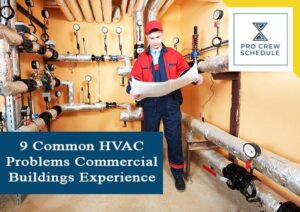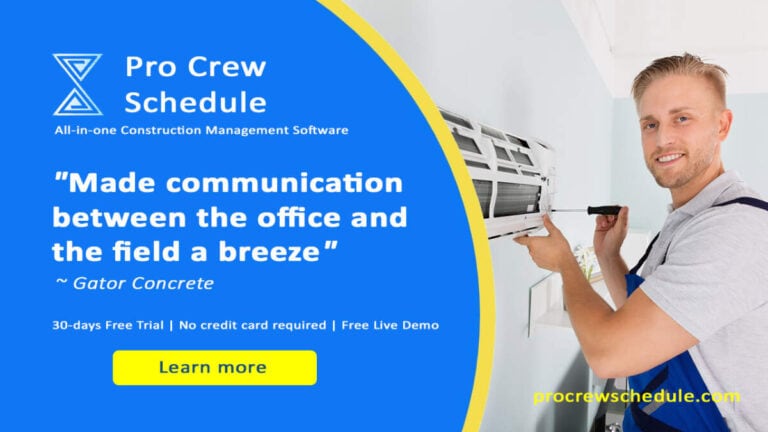Project management for construction is crucial if you want the project to progress smoothly. The same goes for managing commercial buildings and their HVAC systems. Well-running HVAC systems in commercial buildings are essential to the comfort and safety of the occupants.
From the start, HVAC systems must be of high quality and suited for the building, its location, and purpose. This responsibility falls on the HVAC contractor. Working on large jobs, such as construction or installation for commercial buildings, using the best construction management software will save time and improve productivity.
Installing great units is one thing, but the majority of the work comes in maintaining them. That job falls on the building owner, manager, and occupants. If they neglect to take proper care of the systems, several issues could arise that could turn into significant problems.
Commercial vs. Residential HVAC
The most notable difference between commercial and residential HVAC systems is their size. Because commercial buildings are more extensive and broader, their systems must also be bigger to cater to the increased power.
In addition to that, commercial systems are more complex. Its structural engineering involves intricately designing where each piece of equipment would go. This means that its maintenance requires more effort and is more intensive than that for residential ones.
To know more about the difference between commercial and residential HVAC, read our article “Commercial And Residential HVAC: What’s The Difference?”
Commercial Building HVAC Problems
1. Strange noises
When odd noises start to come from the equipment or are louder than usual, it could indicate serious problems.
First, check to see if the rattling or banging noises are just because of loose or unfastened components, doors, panels, or parts. Screeching or squealing might mean that a moving part, like a fan, needs lubrication or replacement.
If the gas furnace lets out banging or popping sounds, this might mean that gas is silently building up and burning off. If not checked immediately, this could lead to significant problems.
2. Inconsistencies with airflow
The conditioned or heated air travels through a series of ducts, comes out through vents, and reaches the rooms. There are times when one room is freezing while the other is boiling. If the occupant/s did not intentionally set it this way, it might be because of leaks or cracks in the ductwork.
To help control airflow, dampers reduce airflow in one line while more conditioned air flows to other areas. In times when areas or rooms heat or cool faster than the rest, the dampers may not be balanced.
3. Drain line clogs
The purpose of the drain line is to direct excess condensation and water away from the unit. Over time, it can become clogged because of dirt and algae accumulation. Water will then back up into the drain pan, leading to major leaks and water damage.
To prevent this problem from happening, it’s recommended to check and clean the drain line regularly.
4. Poor air quality
When air is released through the units, it should be clean. This is where air filters come in– they clean the air of atmospheric aerosol particles (particulates) like pollen, dust, and pet dander before moving through the systems. This process is what keeps the indoor air clean. More often than not, the air filters need to be checked and changed when the air quality seems to decrease.
On the other hand, cooling systems are also expected to dehumidify the indoor environment to some degree. If the humidity continues to increase, this may call for preventative maintenance.
5. Electrical issues
Sometimes, the HVAC system unexpectedly shuts down. When this occurs, it might be because of a blown fuse. If this is the case, take a look at the circuit breaker.
If the HVAC cycles on and this frequently happens, the problem might be with the air conditioner’s capacitor. This component makes sure the electric current is even through the condenser. Fuses are likely to blow if the capacitor breaks or malfunctions.
Because this problem is dangerous, intricate, and expensive, it’s best to let the professionals handle it.
6. Malfunctioning thermostats
When a building starts experiencing HVAC problems, people often think it’s with the actual system and equipment. However, it’s just as likely that the problem is with the thermostat instead.
The thermostat is the central system that controls the timing and temperature the unit creates. So a malfunctioning thermostat will affect the amount of hot and cold air the unit produces, as well as the timing. Consequently, this will result in intermittent temperature fluctuations that will contribute to the occupants’ discomfort.
Most of the time, a simple battery change is all it needs. Many manufacturers recommend replacing the batteries once a year. But it’s wise to check the indicator on the digital display. When this doesn’t cut it, there may be a problem with the electrical wiring.
7. Clogged or dirty filters
Dirty and clogged filters are a factor when it comes to the decrease of air quality. More than that, they can increase energy costs and significantly reduce the system’s lifecycle.
When an air conditioning unit uses worn and dirty filters, it is forced to work harder. Because of this, an unnecessary amount of energy is used, and it exerts more power than needed. This can lead to serious system damages and even total failure.
The best thing to avoid this problem is by periodically checking and replacing the air filters, preferably once a month. Furthermore, prevention can be attained through limiting or prohibiting factors that can contribute to blocking air filters. This includes allowing pets or smoking in the building.
8. Refrigerant leaking
Essentially, refrigerants are what cool and condition the air. Contained in the system’s coils, this liquid substance dehumidifies and removes heat, producing cool air.
When refrigerants leak, the air conditioning unit won’t have enough to do its job, producing insufficiently cold air properly. Superficially, this problem would make the inside of the building hot and the occupants uncomfortable. Subsequently, the condenser will work overtime, which can cause more expensive system problems. Usually, refilling or recharging the refrigerant would suffice to fix the problem.
However, there are times when the air conditioner’s evaporator coils freeze over. It develops a thick layer of frost that inhibits the equipment’s ability to cool. A simple yet effective solution to this is to defrost the coils and remove the ice buildup. This is usually enough to get the system to work correctly again.
9. Mold
Mold is one of the worse problems any building can have. Mold in the HVAC system is particularly troublesome, especially for office buildings. The musty smell hinders the occupants from being productive. More than that, it has adverse effects on their health– coughs, headaches, nausea, and fatigue are just some of the symptoms. With it being in the system, it can quickly spread throughout the building. This is one of the significant reasons why healthy and quality indoor air is crucial for commercial buildings.
The ducts are prone to mold because of their warm location with high water vapor content. When cold air passes through the ducts, water vapor can develop in them. The water droplets from the high water content from the outside environment will collect instead of evaporating. If this happens, the most conducive environment for mold growth is formed.
It grows and spreads when fed its nutrition, usually from pollen, dead skin cells, dust, and dander that accumulate in the ducts with the water.
When the HVAC system has a mold problem, it should be dealt with immediately and carefully. The solution was chosen (or made) could get rid of the mold or do the opposite. To cater to safety and get the best results, use an EPA-approved mold removal solution. Then, gear up a mask, goggles, overalls, and industrial-grade gloves.
Before removing the mold, make sure to turn off the heating and cooling vents. You can then start scrubbing with a light brush or a wet rag. Dispose of the rags in thick airtight trash bags.
Finally, look for EPA-registered mold growth inhibitors to prevent the mold from coming back.
The need for maintenance
In several of our articles, we have reiterated the importance of preventative HVAC maintenance. While it may seem like a tedious yet taxing job, keeping systems in tip-top shape presents plenty of benefits.
For one, it saves money. Keeping systems in prime condition, like effectively managing construction projects, will reduce the risk of failures, decreasing the cost for repairs. More than that, energy costs are cut. Depending on the system and equipment, HVAC energy costs are reduced by 5% to 40% with proper maintenance.
More importantly, people will get better air quality. According to the US Environmental Protection Agency (EPA), studies of human exposure to air pollutants show that indoor levels are higher by two to five times– sometimes more than 100 times, compared to outdoor levels. So, making sure that the system is performing at peak efficiency is critical.
If you’re an HVAC contractor looking for effective and efficient project management software, use Pro Crew Schedule’s HVAC Contractor Software. Sign up today and get a free 30-day trial with all its features and no strings attached. Request a demo now!
.







